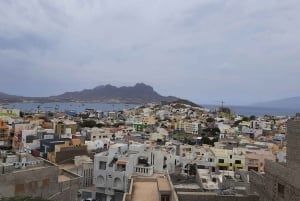Cape Verde Emigration
The creole word for emigration -emigrasãu- in Cape Verde, is commonly associated with leaving the country in order to work abroad, generally with the intention to return to the homeland one day. Traditionally, many Cape Verdeans have had this dream of migrating, in order to achieve a better standard of living. While the initial idea is always to return and live a comfortable life, many people never quite get around to doing it. However, Cape Verde´s economic success in the later years has inspired many Cape Verdeans from the diaspora to relocate to the archipelago or, in some cases, to invest there, while stlll living abroad.
Cape Verde has always been a country of emigation. Today, there are twice more Cape Verdeans living abroad than in their home country. The diaspora comprises 700,000 individuals, most of them located in the US (260,000) and Europe, with 100,000 in Portugal.
The country depends heavily on tourism, remittances and human resources from the diaspora, which is largely represented as an important part of the culture in Cape Verdean art and music. The government´s incentives for people from the diaspora to invest in Cape Verde´ development, alongside the Mobility partnership with the European Union, are being instrumental in managing the impacts of migartion in both directions.
Cape Verdeans in the USA
In the beginning of the 19th century, a wave of Cape Verdean immigrants reached New England aboard whaling ships. American captains valued Cape Verdean seamen because they worked hard and for less money than American crews, and they were regarded as disciplined and honest.
In the 20th century, when the big draught hit Cape Verde, men started taking to the whaling ships massively. From their new homes in Massachusetts and Rhode Island, the immigrants who had escaped the threat of starvation were able to send money and goods to their families in Cape Verde. The largest Cape Verdean communities are still located in these two states, and the practice of sending money home is still the norm, not only in the US, but also in Europe.
Cape Verdean immigration to the US followed the ebb and flow of American immigration laws, when the laws relaxed, immigration boomed, and when they became restrictive, immigration dwindled. Today, the Cape Verdean community in the US is well established, with their own cultural centers, activities and sports leagues, notably football leagues.
Cape Verdeans in Europe
Independence from Portugal caused a big wave of emigration from former colonial officers to their place of origin in the 1970s. Between the 1980s and the 1990s, about 7 to 8 in every 10 Cape Verdean emigrants chose Europe as their destination. The tightening of policies both in Portugal and in Northern Europe in the late ´90s caused a significant reduction in emigration to Europe.
There are large Cape Verdean communities in many European countries, and there has been internal emigration between them as well. Portugal, the Netherlands, France and Italy are home to some of the most sizeable communities in the continent.
The diaspora´s driving power
The Cape Verde government encourages people from the diaspora to set up their businesses in the homeland or buy shares in companies that were formerly owned by the state. For example, in the privatization plans for TACV, the country´ national airline, 15% of the stocks are reserved for emigrants.
The different generations of immigrants are sometimes very dissimilar. The first generation are usually not very educated, though they have stronger bonds with Cape Verde. However, the younger generations are more qualified, and they have a lot to offer the country in terms of competencies and human resources. Many second generation immigrants pursue careers in tourism, thinking of using this knowledge in Cape Verde at a later time.
Cape Verdean communities abroad are also used to funding development projects in Cape Verde directly, sometimes with aids from the local governments.
Direct collaboration between the regions of immigration and Cape Verde also exist, such as the development cooperation between Rotterdam and Praia, and aid from Luxembourg, a country where Cape Verdeans constitute the largest non-European population.
Moreover, diaspora Cape Verdeans have an impact on the tourism industry, as they usually enjoy taking vacations in Cape Verde. These are all different ways in which the diaspora contributes to the development of Cape Verde, other than the transfer of remittances, a source of income which is so dependent on the ups and downs in other areas of the world as well as social factors, that the Cape Verde government is trying to stop its economy from relying so heavily on it.
Reverse Immigration
In line with the Cape Verdean emigrasãu dream, many immigrants are currently choosing to return to Cape Verde. Some older ones are retired and rely on pensions from abroad for their livelihood. While some of these pensions do not seem like much in Europe, they make for a comfortable life in Cape Verde.
Some of these older immigrants invest on building homes before returning to Cape Verde, usually making sure there are two or more homes in the property, so they can rent them out. Others start a small business, like owning a taxi or a small shop, which doesn´ require much expertise or investment.
On the other hand, younger, more educated returnees can take on careers related to tourism or start new developments, while the wealthier group can profit from the incentives and invest some of the funds acquired abroad in a variety of business and development projects.
Integration of former immigrants into Cape Verde society tends to be smooth, regardless of socio-economic levels, and the outlook seems to be very bright, both for returnees and for investors from the diaspora.
Famous people with Cape Verdean dissent include numerous football players such as Nani and Henrik Larsson. Basketballs NBA star Danna Barros and musicians such as Sara Tavares and Lura.












